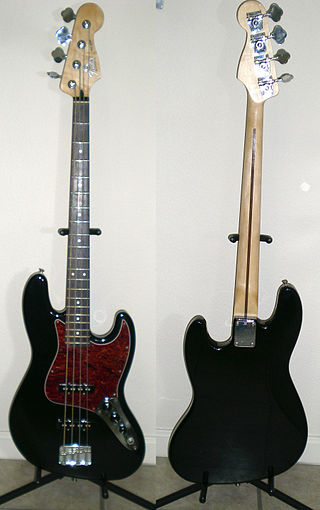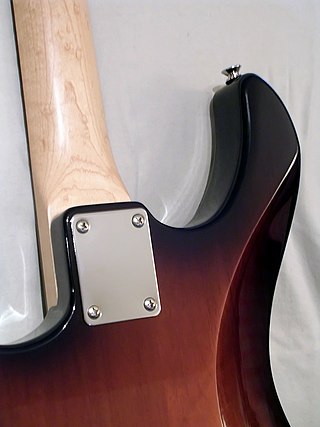
An electric guitar is a guitar that requires external electric sound amplification in order to be heard at typical performance volumes, unlike a standard acoustic guitar. It uses one or more pickups to convert the vibration of its strings into electrical signals, which ultimately are reproduced as sound by loudspeakers. The sound is sometimes shaped or electronically altered to achieve different timbres or tonal qualities via amplifier settings or knobs on the guitar. Often, this is done through the use of effects such as reverb, distortion and "overdrive"; the latter is considered to be a key element of electric blues guitar music and jazz, rock and heavy metal guitar playing. Designs also exist combining attributes of electric and acoustic guitars: the semi-acoustic and acoustic-electric guitars.
Ibanez is a Japanese guitar brand owned by Hoshino Gakki. Based in Nagoya, Aichi, Japan, Hoshino Gakki were one of the first Japanese musical instrument companies to gain a significant foothold in import guitar sales in the United States and Europe, as well as the first brand of guitars to mass-produce seven-string and eight-string guitars. Ibanez manufactures effects, accessories, amps, and instruments in Japan, China, Indonesia, and the United States. As of 2017 they marketed nearly 165 models of bass guitar, 130 acoustic guitars, and more than 300 electric guitars. After Gibson and Fender, Ibanez is considered the third biggest guitar brand.
The Fender Stratocaster, colloquially known as the Strat, is a model of electric guitar designed between 1952 and 1954 by Leo Fender, Bill Carson, George Fullerton, and Freddie Tavares. The Fender Musical Instruments Corporation has continuously manufactured the Stratocaster since 1954. It is a double-cutaway guitar, with an extended top "horn" shape for balance. "Stratocaster" and "Strat" are trademark terms belonging to Fender. Guitars that duplicate the Stratocaster by other manufacturers are sometimes called S-Type or ST-type guitars. Many prominent rock musicians have been associated with the Stratocaster for use in studio recording and live performances, most notably Eric Clapton, Buddy Holly, David Gilmour, Mark Knopfler, Jimi Hendrix, Stevie Ray Vaughan, John Frusciante, Jeff Beck, George Harrison, and Tom Petty.

Epiphone is an American musical instrument brand that traces its roots to a musical instrument manufacturing business founded in 1873 by Anastasios Stathopoulos in İzmir, Ottoman Empire, and moved to New York City in 1908. After taking over his father's business, Epaminondas Stathopoulos named the company "Epiphone" as a combination of his own nickname "Epi" and the suffix "-phone" in 1928, the same year it began making guitars. From the 1930s through to the early 1950s, Epiphone produced a range of both acoustic and (later) electrified archtop guitars that rivalled those produced by Gibson and were the instruments of choice of many professionals; a smaller range of flat-top guitars were also produced, some designations of which were later continued during the Gibson-owned era for the company.

The Fender Showmaster is a discontinued model of electric guitar made by Fender, and is characteristic of a superstrat.

Music Man is an American guitar and bass guitar manufacturer. Originally formed in 1971 by Forrest White and Tom Walker, along with Leo Fender as a silent partner, the company started manufacturing electric and bass guitars under the Music Man name in 1974. In 1984 it was acquired by Ernie Ball, and renamed Ernie Ball Music Man.

The Fender Precision Bass is a model of electric bass guitar manufactured by Fender Musical Instruments Corporation. In its standard, post-1957 configuration, the Precision Bass is a solid body, four-stringed instrument usually equipped with a single split-coil humbucking pickup and a one-piece, 20-fret maple neck with rosewood or maple fingerboard.

The Fender Jazz Bass is the second model of electric bass created by Leo Fender. It is distinct from the Precision Bass in that its tone is brighter and richer in the midrange and treble with less emphasis on the fundamental frequency. The body shape is also different from the Precision Bass, in that the Precision Bass has a symmetrical lower bout on the body, designed after the Telecaster and Stratocaster lines of guitars, while the Jazz Bass has an offset lower bout, mimicking the design aesthetic of the Jaguar and Jazzmaster guitars.
Variax was the name of a line of guitars developed and marketed by Line 6 between 2002 and 2023. They differed from typical electric and acoustic guitars in that internal electronics processed the sound from individual strings to model (replicate) the sound of specific guitars and other instruments. The maker claims it was the first guitar family able to emulate the tones of other notable electric and acoustic guitars. It also provided a banjo and a sitar tone. The Variax was available primarily in electric guitar models, but acoustic and electric bass guitar models have also been available in the past.
The Jackson Soloist is an electric guitar model introduced by Jackson Guitars in 1984, although prototypes were available before then. The design is a typical "superstrat"; it varies from a typical Stratocaster because of its neck-thru design; tremolo: Floyd Rose or similar, Kahler; or a fixed Tune-O-Matic; premium woods; a deeper cutaway at the lower horn for better access to the higher frets, and a sharper body with squared-off edges.

Bolt-on neck is a method of guitar construction that involves joining a guitar neck and body using screws or bolts, as opposed to glue and joinery as with set-in neck joints.
The Guild Guitar Company is a United States–based guitar manufacturer founded in 1952 by Alfred Dronge, a guitarist and music-store owner, and George Mann, a former executive with the Epiphone Guitar Company. The brand name currently exists as a brand under Córdoba Music Group. In February 2023, The Yamaha Guitar Group acquired Cordoba Music Group.
A solid-body musical instrument is a string instrument such as a guitar, bass or violin built without its normal sound box and relying on an electromagnetic pickup system to directly detect the vibrations of the strings; these instruments are usually plugged into an instrument amplifier and loudspeaker to be heard. Solid-body instruments are preferred in situations where acoustic feedback may otherwise be a problem and are inherently both less expensive to build and more rugged than acoustic electric instruments.

The Fender Coronado is a double-cutaway thin-line hollow-body electric guitar, announced in 1965. It is manufactured by Fender Musical Instruments Corporation. The aesthetic design embodied in the Coronado represents a departure from previous Fender instruments; the design remains an uncharacteristic piece of Fender history.

Greco is a Japanese guitar brand owned by the Kanda Shokai Corporation (in Japanese) 神田商会, a musical instrument wholesaler mostly known for being part of Fender Japan. Instruments manufactured with the name "Greco" are electric and acoustic guitars.
Tacoma Guitars was an American manufacturing company of musical instruments. It was founded in 1991 as a division of South Korean company Young Chang. Instruments were manufactured in Tacoma, Washington. The company and brand name were later acquired by the Fender Musical Instruments Corporation. The Tacoma plant closed, and production ceased, in 2008.
The Fender Bullet was an electric guitar originally designed by John Page and manufactured and marketed by the Fender Musical Instruments Corporation. It was first introduced as a line of "student" guitars to replace the outgoing Mustang and Musicmaster models.
Electric guitar design is a type of industrial design where the looks and efficiency of the shape as well as the acoustical aspects of the guitar are important factors. In the past many guitars have been designed with various odd shapes as well as very practical and convenient solutions to improve the usability of the object.
The Fender Wildwood guitar was a flat-top acoustic guitar introduced by the Fender company in 1966.
The Fender Telecaster, colloquially known as the tele, is an electric guitar produced by Fender. Together with its sister model the Esquire, it was the world's first mass-produced, commercially successful solid-body electric guitar. Its simple yet effective design and revolutionary sound broke ground and set trends in electric guitar manufacturing and popular music. Many prominent rock musicians have been associated with the Telecaster for use in studio recording and live performances, most notably Bruce Springsteen, Luis Alberto Spinetta, Keith Richards and George Harrison.








